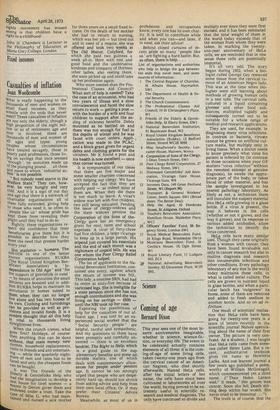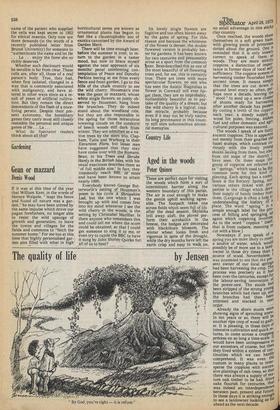Science
Coming of age
Bernard Dixon
This year sees one of the most bizarre anniversaries imaginable, whether in science, science-fiction, or everyday life. The event to be celebrated actually contains elements of all three: it is the coming-of-age of some living cells, taken twenty-one years ago from the cervical cancer of an American Negress, who died shortly afterwards. Named HeLa cells, after the initial letters of her name, the cells have since been cultivated in laboratories all over the world, having proved to be extremely useful in scientific research and medical diagnosis. The cells have continued to divide and
537 multiply ever since they were first excised, and it has been estimated that the total weight of them in the world today exceeds that of the woman from whom they were taken. In marking the twentyone-year anniversary of HeLa cells, we are reminded that in one sense these cells are potentially immortal.
It's all very odd. The story began during 1952, when a biologist called George Gey removed some tissue from the cervical tumour of an American Negro lady, This was at the time when biologists were still learning about methods of growing human cells in a test tube. The cervical cells, cultured in a liquid containing glucose and other food substances, multiplied rapidly and subsequently turned out to be suitable for a whole range of medical and research applications.
They are used, for example, in diagnosing many virus infections. In contrast to bacteria, viruses cannot be grown on artificial culture media, but multiply only in living tissue. When a doctor needs to know precisely what virus his patient is infected by (in contrast to those occasions when your GP mutters "virus infection" without the remotest attempt at genuine diagnosis), he swabs the appropriate part of the body, or takes blood or other material, and has the sample investigated in his nearest pathology laboratory. As likely as not, a technician there will inoculate the suspect material into HeLa cells growing in a glass bottle. If a virus is present, the way it behaves in the cells (whether or not it grows, and the way it grows), and its response to various added antibodies, allow the technician to identify the virus concerned. I-IeLa cells have many similar uses. Though they came originally from a woman with cancer, they have been found invaluable not only in cancer research but also in routine diagnosis and research into innumerable infectious and other conditions. Every pathology laboratory of any size in the world today maintains these cells, in what is called serial culture. The cells are grown in nutrient liquid in glass bottles, and when a particular batch has 'outgrown' its home, some of them are removed and added to fresh medium in another bottle. And so on ad infinitum. One result of scientists' realisation that HeLa cells have been going for twenty-one years is a spate of letters recently in the scientific journal Nature speculating about the name of their first owner. The picture is very confused. As a student, I was taught that HeLa cells came from someone called Helen Lane. But a re
cent, authoritative textbook gives the name as Henrietta Lacks. And one learned journal a few years ago published a poem, worthy of William McGonagall, which commemorated yet a third name. ("Then Helen Larson wed," it reads. " Her groom was cancer. Soon she felt Death stirring deep within her womb. She never tried to be immortal ...")
The truth is, of course, that the name of the patient who supplied the cells was kept secret in 1952 for ethical reasons. Only now are there demands (in the words of a recently published letter from Brunel University) for someone to "authenticate the name and let He . . . La . . . enjoy the fame she so' richly deserves."
Whether such disclosure would be sensible is far from clear. These cells are, after all, those of a real person's body. True, they had, when first isolated, changed in a way that is commonly associated with malignancy, and have altered in other ways since as a resuit of years of artificial cultivation. But they remain the direct descendants of the flesh of a onceliving person. Despite their present autonomy, the hereditary' genes they carry must still closely' resemble the personal and unique genes of He ... La ...
What do Spectator readers think about all this?



































 Previous page
Previous page